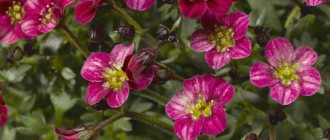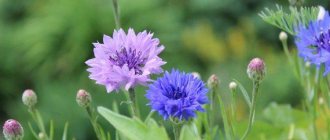Author: Elena N. https://floristics.info/ru/index.php?option=com_contact&view=contact&id=19 Category: Garden plants Published: February 14, 2019Last edits: January 13, 2021
- Growing conditions
- Propagation by cuttings
- Five-leaved maiden grape (Parthenocissus quinquefolia)
Maiden grape, or Virginia grape (lat. Parthenocissus) is a genus of plants of the Grape family, which has about 10 species that grow wild in Asia and North America. The Latin name comes from the Greek words meaning "virgin" and "ivy", and refers to the plant's ability to produce fruit without pollination. Three species of this genus are grown as ornamental plants. Maiden grapes have been used in landscape design since the 17th century to decorate gazebos and terraces, decorate the walls of houses and outbuildings, create hedges and even as a ground cover plant.
Planting and caring for virgin grapes
- Planting: sowing seeds - throughout the season.
- Flowering: the plant is grown as an ornamental foliage plant.
- Lighting: bright sunlight, bright diffused light or partial shade.
- Soil: any cultivated soil, but the best is loam with a reaction ranging from slightly acidic to slightly alkaline.
- Watering: rare (3-4 times per season), but plentiful (10 liters for each plant); between waterings, the soil in the tree trunk circle should dry out.
- Top dressing: at the beginning of summer, Nitroammofoska is added to the water for irrigation, and in the middle of summer, a solution of complex mineral fertilizer is added to the tree trunk circle. The tree trunk circle is mulched with compost, peat or humus, and the thickness of the mulch layer should be 5-6 cm. In the fall, this mulch is embedded in the soil.
- Garter: the plant needs support only until it begins to develop tendrils that cling to any roughness.
- Pruning: the plant needs formative pruning, which is best done in early spring.
- Reproduction: by seeds, but more often vegetatively: cuttings, layering and root suckers.
- Pests: aphids.
- Diseases: rot.
Read more about growing virgin grapes below.
Problems during cultivation
In addition to plant parasites, ordinary care errors, as well as non-compliance with the basic rules of growing technology, can also harm indoor cissus plants.
Leaves dry out and fall off
Quite often you can observe when cissus leaves fade, dry out and fall off. As a rule, this situation occurs when growing a plant in a room that is too dry and hot. The situation can be corrected by changing the location of the plant and spraying it. Similar problems can also be caused by temperature changes and rotting of the root system.
The leaves have turned yellow
Yellowing of the foliage along the veins is characteristic of spider mite damage. In case of serious, widespread damage, systemic insecticidal agents are used. In addition, yellowing of the foliage may be associated with a violation of the watering regime and lack of nutrition. In this case, it is necessary to feed the plant with microelements.
Brown spots on leaves
The reason for the appearance of brown spots on cissus leaves is most often a lack of phosphorus or nitrogen nutrition of the plant. However, brown spots with elements of mold may indicate waterlogging of the soil in the flower pot and problems with the root system of the plant.
Brown tips on leaves
Darkening of the tips of the leaves can be a consequence of a violation of the watering regime, and also very often occurs when fertilizers of unsuitable composition are used for fertilizing. It is recommended not only to adjust the irrigation regime, but also to change the fertilizer used to feed the plants. When changing fertilizers, you should carefully monitor the plant’s reaction to the fertilizing.
Botanical description
Many lovers consider this plant to be a wild grape, but this is not so: virgin grapes have nothing to do with edible types of grapes. It is a large deciduous, less often evergreen, vine, the old branches of which are covered with dense bark. The leaves of the plant are compound, palmate, sometimes three-lobed, located on long petioles. In spring and summer, the leaves of the maiden vine are dark green, and in the fall they acquire a bright purple hue. The climbing shoots of the vine, clinging to the support with branched tendrils, can reach a length of 15-20 m. Corymbose hanging inflorescences develop opposite the leaves or in their axils. The inflorescences consist of bisexual or staminate flowers with a greenish corolla. The fruits are inedible dark blue berries.
What is the attractiveness of girlish grapes for gardeners and designers? It is decorative throughout the season, provides a dense camouflage curtain, is not afraid of frost, grows on any soil, does not need a large feeding area, is resistant to diseases and pests, grows very quickly, does not require fertilizing, reproduces easily and perfectly protects any walls from dust, overheating, rain, wind, and also eliminates dampness near the foundation and even indoors.
The plant also has disadvantages: firstly, the grape shoots crawl under the roof and destroy it, and if they get into the gutter, they clog the drain. Secondly, the aggressive roots of the maiden vine spread for several meters around, causing disturbance to other plants, and can cause the destruction of the foundation. Thirdly, in the spring, virgin grapes take a very long time to wake up, and the sight of its bare, tangled shoots against the backdrop of a green garden does not inspire optimism.
- Grape varieties Talisman - why is it not as bad as they say?
However, if you wish, you can come to terms with all these shortcomings, since the decorativeness and unpretentiousness of girlish grapes are beyond praise.
Cissus: can you keep it in the house - useful properties and signs
Thanks to the high bacterial and phytoncidal activity of the indoor flower, the atmosphere in the home is cleansed. Microcomponents released by cissus kill bacteria that cause allergic diseases and gastrointestinal disorders.
Decorative vine perfectly humidifies the air in the room and absorbs excess dust.
Helps get rid of formaldehyde - fumes from building materials, which often cause headaches, provoke nausea, and irritate the respiratory system.
Several pots of plants in the room increase vitality and reduce fatigue.
Popular signs and superstitions associate the cissus flower, like most lianas, with a muzhigon flower, that is, the flower is capable of surviving a spouse from home. Whether or not to keep hanging plants at home is up to everyone to decide for themselves; most flower growers do not pay attention to these myths.
Planting girlish grapes in the garden
When and where to plant
You can propagate virgin grapes in different ways, but if you are not in a hurry and like experiments, we recommend that you try growing virgin grapes from seeds. Sowing can be done throughout the season. Before spring or summer sowing, the seeds must undergo stratification, for which they are first kept in cold water to swell, then placed in a container with damp sand and placed for two months in the vegetable drawer of the refrigerator, where they are kept at a temperature of about 5 ºC. If you decide to sow the seeds of virgin grapes before winter, at the end of September or beginning of October, then you only need to keep them for 3-4 days in cold water for swelling, and you do not need to stratify them: during the winter months in the soil they will undergo natural stratification, and they will rise together next year. Whenever you sow virgin grapes, its seeds are first soaked in water.
Maiden grapes don’t care where they grow, but their decorative properties directly depend on the degree of illumination: the color of grape leaves is always brighter in the sun. And virgin grapes grow faster in a sunny area. Maiden grapes grow poorly where cold winds blow in autumn. Do not plant the plant near water pipes or sewers, or near wires. It is better to choose a place close to plastered brick walls, concrete or wooden fences, gazebos or sheds.
How to plant
As already mentioned, any cultivated soil is suitable for virgin grapes, but the best soil for it is loamy soil with a neutral, slightly acidic or slightly alkaline pH. Seeds are sown in loosened soil to a depth of 1 cm, planted and watered.
Let's sum it up
Decorating a plot with grapes is not an original idea, but it is consistently attractive to almost all gardeners. From the technical side, there are no problems with this design.
The main difficulties arise in drawing up a decor project, since the rapid growth of plants does not allow the results to be preserved for a long time. However, if you make constant corrections, you can stabilize the design of the site and maintain it in the desired form.
Previous
Questions and answersGrapes and health: the benefits of berries, seeds and leaves for humans, possible negative consequences
Next
Growing and careAll about feeding grapes: fertilizers, equipment, seasonality
Caring for virgin grapes
Growing conditions
Growing maiden grapes largely comes down to occasional watering during long droughts, removing weeds and trimming vines, but if you want to see the plant in its best form, give it a little more time than necessary.
Young plants need support until they develop tenacious tendrils capable of holding the vine on a rough surface. You will have to water the virgin grapes 3-4 times per season, spending 10 liters of water on each plant at a time. Watering is carried out when the top layer of soil dries out under the bush.
At the very beginning of summer, Nitroammofoska should be added to the water for irrigation, and at the height of the season, it is advisable to feed the grapes with complex mineral fertilizer. After watering or rain, the soil around the plant needs to be loosened, and if you find areas with bare roots, add soil under the grapes. A good effect is achieved by mulching the tree trunk circle with a 6 cm thick layer of compost, humus or peat - in the autumn the mulch is embedded in the soil, and new mulch is poured on top.
Transfer
Sometimes it becomes necessary to transplant a maiden grape bush to a more suitable place for it. The sooner this need arises, the easier it will be to replant the bush, although there are cases of successful relocation of bushes that are five years old and even more mature.
Prepare in advance a hole for the plant of approximately the same size as the root system of the bush along with the earthen ball, but greater depth. At the bottom of the hole, pour a layer of drainage (broken brick, crushed stone or crushed ceramic tiles) about 15 cm thick, pour a twenty-centimeter layer of sand on top, and then fill the hole to the middle with a mixture of leaf soil, humus and sand in a ratio of 2:2:1.
After two weeks, when the soil in the hole settles and becomes compacted, cut off the vines of the girl’s grapes so much that it is convenient for you to replant them, dig up the bush, transfer it to a piece of thick fabric or oilcloth and drag it to the new hole. It doesn’t matter if you fail to preserve all the roots of the girl’s grapes - it will recover very quickly if the new place suits it.
How to plant girlish grapes? Lower the earthen ball with roots into the hole and fill the remaining space with the same soil mixture. The root collar of the bush should remain at ground level. After transplanting, water the bush, add more soil if necessary and compact the surface.
If you have doubts about whether the bush will take root, add a little root former - Epin or Kornevin - to the hole before planting.
Trimming
The first two to three years after sowing or planting, virgin grapes are unattractive, but when active growth of shoots begins, it is very important to form the skeleton of the plant in such a way that the vines grow in the right direction and at the right distance from each other, forming a certain shape and reasonable density. Form the crown of the bush with garden pruners. Do not delay the beginning of pruning, do not allow the shoots to become lignified and, while they are still green, direct them in the direction you need and fix them on a support. Remove excess shoots by making a cut above a healthy bud.
- How to grow gladioli in the garden (video)
When the skeletal branches are formed, all you have to do is carry out sanitary cleaning of the bush in the spring and limit the growth of shoots, not allowing them to grow, otherwise the maiden grapes will turn into lush, sloppy thickets. It is especially important to keep your maiden vine hedge in good shape.
Pests and diseases
Neither diseases nor pests show interest in virgin grapes, but if not properly cared for, the plant can be affected by rot, as the appearance of the leaves will tell you. Remove diseased leaves and shoots, stop watering the grapes and treat the plant with a fungicide solution.
If any pest settles on the virgin grapes, feel free to treat the plant with an insecticide.
Site design options
When choosing grapes as a decorative element, you need to immediately think about its purpose - whether it will be purely for decoration, or whether it is desirable to combine it with practical use, getting a harvest of berries from the plants. This determines what grape variety will be used and what structure will serve as a supporting structure.
If you only need to decorate the area, create an attractive decor for buildings or fences, the best option would be maiden grapes resting on the walls of the house, gazebos, fences or other types of supports.
To obtain a harvest, you will have to combine the decorative and practical qualities of plants. In such cases, trellises are usually made in the form of terraces, arches or canopies (pergolas).
These structures allow you to place the plants so that they are in normal conditions, well lit by the sun, and the bunches hang freely and do not encounter obstacles.
An important point will be the density of the plant - there are varieties that are not able to tightly braid the proposed support. If you need to create a dense green curtain - a hedge, the walls of a gazebo, or hide unattractive surfaces - you should choose denser decorative varieties (it is best to use varieties of maiden grapes).
When decorating a site, you can use two ways:
- Make special supports for grapes with the expectation that they will become overgrown with green mass. This will require a lot of effort, time and materials.
- Decorate existing structures or surfaces. this will require a minimum of costs - in the right places they strengthen the chain-link mesh or gratings from slats, which you can make with your own hands or purchase in a store.
Both options are good in their own way, but the final choice is made based on your own capabilities, both technical and financial.
Reproduction
Propagation by cuttings
You already know how to grow virgin grapes from seeds, but the easiest and most affordable way to propagate a plant is by cuttings. How to propagate virgin grapes from cuttings? After cutting the plant, sections of lashes and shoots remain, which can be used as cuttings. Lignified cuttings the thickness of a pencil, which have 3-5 healthy buds, take root more easily.
Cuttings, like sowing virgin grapes, can be carried out throughout the entire growing season. Take a suitable branch and cut cuttings from it 25-30 cm long with the required number of buds. Dig holes 7-10 cm deep in the prepared area at a distance of 1.5-2 m from each other, place the cuttings of the maiden grapes so that at least two buds are underground, fill the holes, compact the surface and water the planting. In hot summers, maiden grape seedlings need to be watered regularly until they begin to actively grow. And do not forget to protect them from direct sunlight at first.
Reproduction by layering
Spread the vine vine on the ground, attach it to the ground with pins or hooks and sprinkle with fertile soil in places where there are buds on the vine. Water the cuttings, and after a while roots will begin to grow from the buds. If the scourge is short, it is completely laid in a dug groove, leaving only the top on the surface, which needs to be raised to a height of 15-20 cm. The scourge placed in the furrow is covered with earth and regularly watered, and when it takes root and sprouts, the scourge is separated from the mother bush .
Reproduction by root suckers
This is also a convenient way to propagate virgin grapes: the root shoots are dug out from the soil and planted in a new place, where the seedlings grow for a year or two. When transplanting, the root collar should be at the same level as it was. When the seedlings become stronger, they are transplanted to a permanent place.
Introduction
Grape cultivation is not always carried out for agricultural or industrial purposes.
The liana with beautiful carved leaves looks very attractive. It is not for nothing that one of the traditional elements in wood carving is grape leaves. Many owners of private houses decorate their plots with decorative varieties of grapes, the berries of which are not eaten.
As a rule, wild varieties are used, but sometimes the site is decorated with cultivated species. There are many options for designing the territory, which should be discussed in more detail.
Maiden grapes in winter
Maiden grapes overwinter in frosty air: they are cold-resistant and can withstand severe cold snaps. If you are afraid that the winter will be too cold for the plant, lay fresh mulch under the bush, and spruce branches on top of it, remove the vines from the support, lay them with a bedding of spruce branches and throw spruce branches on top. This shelter will be enough. However, make sure that the grapes do not dry out in winter.
As you can see, planting and caring for virgin grapes is so simple that even a novice gardener can do it.
Fruits of the plant
The fruits of the plant are small berries with seeds . Their shape is similar to an ellipse or sphere, and their diameter is only 5-8 millimeters. More than a dozen fruits can grow on one branch. Each fruit contains 3 or 4 seeds, which can later be used to plant seeds. The peel of the fruit is quite elastic and very dense. It can have different colors depending on which variety is being considered (red, blue, burgundy, purple).
All varieties are characterized by a change in the color of the berry during its full ripening . Then the fruits become almost black in color, and a small bluish coating appears on their surface. The taste of the fruit is quite unpleasant. They contain a lot of oxalic acid, due to which the berries acquire a sour-bitter taste, and therefore are considered inedible. In addition, their excessive consumption can cause serious poisoning. However, they are widely used in folk medicine because they have a good astringent effect.
Types and varieties
Five-leaved maiden grape (Parthenocissus quinquefolia)
Or virgin virgin grapes. The most commonly grown grape is the five-leafed maiden grape. This fast-growing, shade-tolerant species is native to eastern North America, where it is found in moist forests and scrubland in rich, moist soils. This is a large vine, the vines of which can reach a length of 20 m. The young shoots of the plant are reddish, but with age they turn green. Antennae with 3-8 branches ending in thickenings. The leaves of this species are compound, palmate, consisting of oblong or ovate petiolate leaflets up to 10 cm long with a pointed apex. The color of the upper side of the leaves is dark green, the lower side of the leaves is lighter, with a bluish tint. Umbrella-shaped apical inflorescences consist of 3-6 flowers. The fruits are blue-black berries with a bluish bloom.
This species is durable, easily reproduces in different ways, tolerates urban conditions well, and is not damaged by fungi and insects. It is so winter-hardy that it overwinters in the middle zone without shelter. However, five-leaf maiden grapes in Siberia still require insulation for the winter. The species has been in culture since 1622. The most valuable decorative forms of five-leaf grapes are:
- Engelman - small-leaved form of the main species;
- wall - the antennae of this variety have numerous branches with thickened suction cups, which allow the lashes to climb a smooth, vertical surface;
- hairy - less winter-hardy, but more attractive form with reddish-colored shoots and leaves, the underside of which is pubescent;
- Saint-Paul is a plant with pubescent shoots at a young age and elongated inflorescences, the tendrils of which have up to 12 branches;
- Star Showers - this variety has marbled foliage: in the warm season it is green with white spots, and in the fall the spots turn pink and the leaves turn red.
Maiden grape (Parthenocissus tricuspidata)
Or ivy is native to Japan, China, the Korean Peninsula and the extreme southwest of Primorye. It is a vine with branched tendrils and a large number of suckers. Various in shape, smooth, as if varnished, leaves up to 20 cm in diameter on one plant can be triangular, three-lobed, round, bladeless, or heart-shaped. In spring the leaves are bright purple; in autumn they turn golden yellow, bronze or bright red. Small, unattractive flowers form oblong clusters of inflorescences. The fruits of this species are the same bluish-black with a bluish bloom, like those of the five-leaf maiden grape.
Tripoint grapes cope well with dust and smoke, but are not particularly winter hardy, although they can withstand short frosts down to -15 ºC. It is successfully cultivated in Ukraine, but in the conditions of the middle zone this grape freezes out in winter. The decorative qualities of plants of this species are admirable. Most often, tripointed girlish grapes are used to decorate walls. This species has been in cultivation since 1862. The most popular forms of triacid grapes in landscape design are:
- Vicha is a plant with small leaves, simple or consisting of three leaves;
- purple - a form with dark purple leaves throughout the growing season;
- golden - a plant with marbled leaves: there are golden-yellow spots on the green foliage.
Maiden grape attached (Parthenocissus inserta)
This is a vine up to 3 m long, the stems of which rise upward with the help of underdeveloped suckers and tendrils. The plant has beautiful palmate-compound leaves, consisting of 3-5 ovate or elliptical leaflets with a wedge-shaped base and a sharp apex. The upper side of the leaves is dark green, shiny, the lower side is matte and lighter. This species is grown in Ukraine, Belarus, Moldova, the Baltic countries and southern Russia, but in the middle zone the attached virgin grapes suffer from frost.
- How to feed plants - simple or complex fertilizers, and how to avoid mistakes when choosing?
In addition to those described, sometimes in cultivation you can find such types of maiden grapes as seven-leaf, Henry and Thomson.
"Living" fence
For hedges, five-leaf grapes are more often used, which can also be used to decorate old trees standing nearby.
In combination with the magical bushes of euonymus, whose leaves turn pink-red in the sun, girlish grapes will delight the eye until frost. Of course, the “fence” effect lasts only from the beginning of summer until October, but living plants miraculously transform the area, presenting even old buildings in an attractive form. Perennial vines: virgin grapes, which acquire a crimson color by autumn, hops, clematis, will create wonderful “scenery” in the garden. Annual plants also look very good in composition with them: beans with purple leaves and large beautiful flowers, and bindweed.
Selection of conditions for a powerful vine
In order for virgin grapes to successfully develop and grow, it does not even need to be particularly careful in selecting certain lighting or soil parameters. This is one of the most unpretentious and hardy garden plants. Maiden grapes are able to adapt to almost any conditions, surviving even where there is no fertile soil or if it grows in limited quantities.
It can be planted both on the most illuminated areas of the garden, suitable for light-loving crops, on the south side of buildings, and in fairly dense shade. These are shade-tolerant, but not shade-loving vines, and it is better to plant it under a dense canopy of trees or on the north side of buildings only when the plant is illuminated by the sun for at least a few hours a day. All types and varieties of virgin grapes achieve their greatest effectiveness in partial shade of varying intensity from deep to diffuse.
As for the soil, any of its deficiencies, from poor cultivation and compaction to poor nutrient content or excessive calcareousness and acidity, can be compensated for by planting. Maiden grapes can grow in literally any soil, even dry, but when planting plants it is necessary to follow some rules of basic agricultural technology. The advantages of virgin grapes include the ability to tolerate replanting at any age.
Maiden grapes











